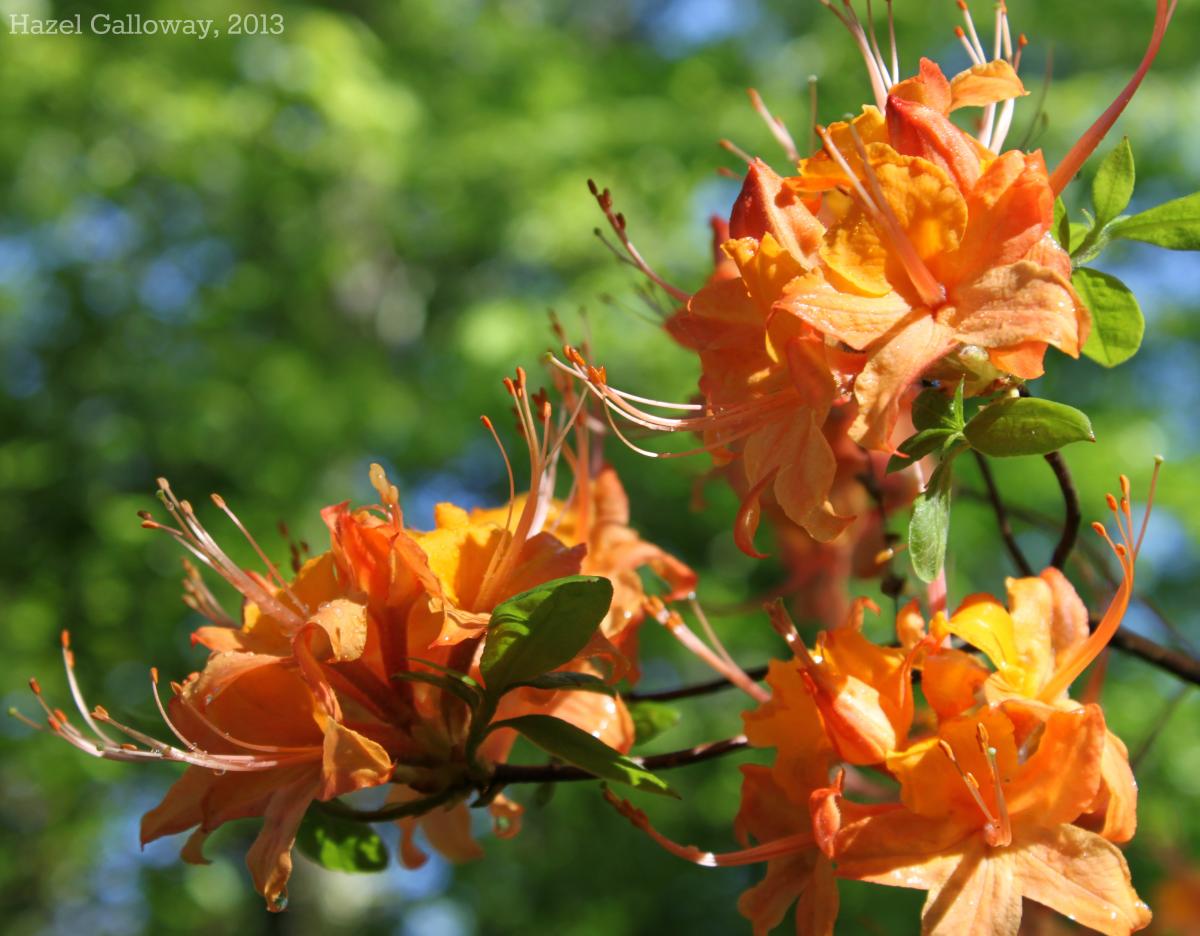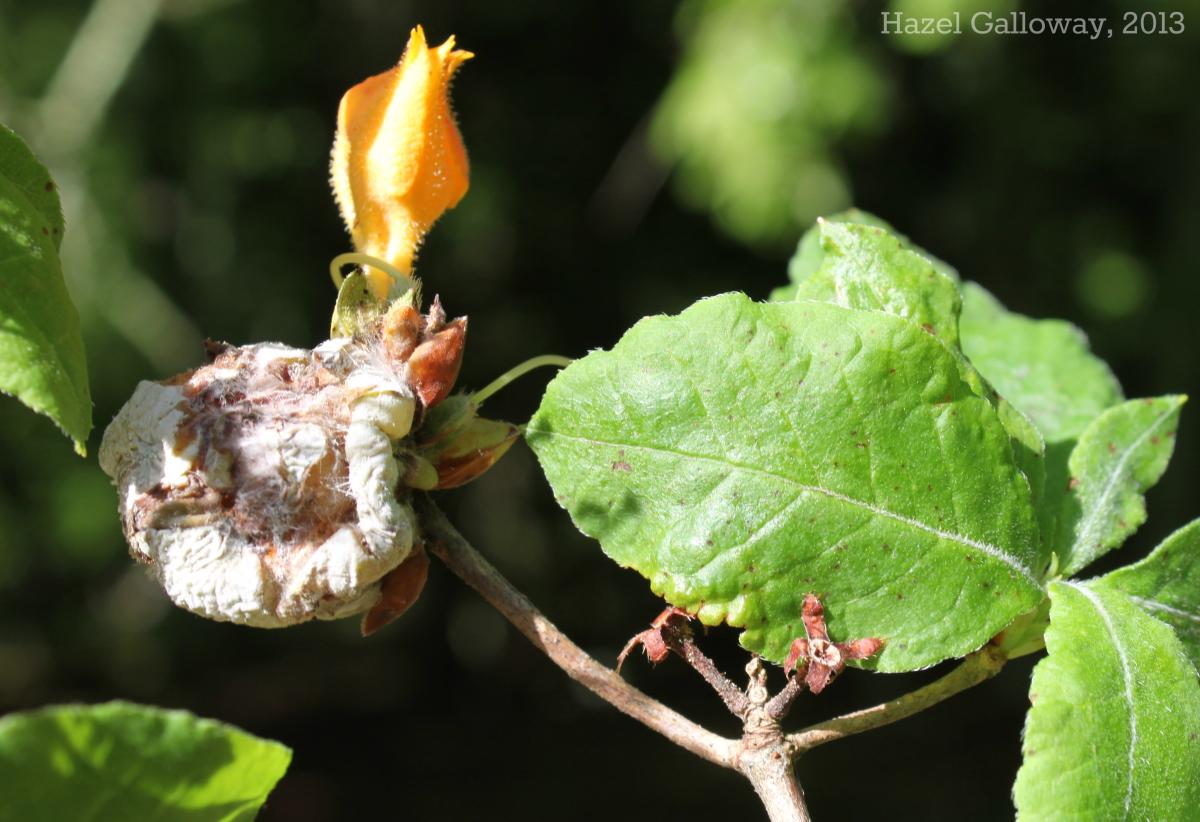 The appropriately-named flame azalea is revealing its splendor this week in the understory around the station. While it is often planted as a horticultural in beds flanked by much-bred cultivars, it can be found occurring naturally at higher elevations along much of the east coast. In the late spring and early summer, it produces striking yellow to orange-red blooms in clusters on the ends of its branches. The funnel-shaped flowers are marked by the unusually long stamens, which are often almost three times as long as the corolla tube. However, it is not the fiery color of the blooms—which reportedly have been mistaken for actual flames when densely covering a hillside—which inspire Rhododendron calendulaceum’s common name. Rather, just before opening, the expanded buds are said to resemble candle flames.
The appropriately-named flame azalea is revealing its splendor this week in the understory around the station. While it is often planted as a horticultural in beds flanked by much-bred cultivars, it can be found occurring naturally at higher elevations along much of the east coast. In the late spring and early summer, it produces striking yellow to orange-red blooms in clusters on the ends of its branches. The funnel-shaped flowers are marked by the unusually long stamens, which are often almost three times as long as the corolla tube. However, it is not the fiery color of the blooms—which reportedly have been mistaken for actual flames when densely covering a hillside—which inspire Rhododendron calendulaceum’s common name. Rather, just before opening, the expanded buds are said to resemble candle flames.
The inflorescences coincide or are closely followed by the appearance of delicate, oval-shaped leaves which grow to be around 8 cm long, and are covered by short hairs on their undersides. Both the leaves and the somewhat hairy, reddish-brown twigs grow in whorls. Like many other species in the genus, such as the Rhododendron maximum responsible for the dense thickets around streams on the mountain, the flame azalea takes the form of a medium-sized to tall shrub. Although they can reach 4.5 m (15 ft) in height, they are decidedly an understory-dweller in this area. However, on open cliffs and hillsides in their native range, they can grow much larger and form dense thickets of their own.
Research has been done on this species at MLBS by Lorne Wolfe, who investigated the relationship between the plant and a fungal pathogen, Exobasidium vaccinii. E. vaccinii, which produces large and fleshy galls on infected plants, was found on 10-90% of individuals, depending on the study site. Wolfe found that the galls had immediate negative effects on the azalea’s reproduction. “Individuals infected in 1997 were less likely to flower the next season. Diseased inflorescences produced fewer flowers, smaller  individual flowers, and had a lower probability of producing fruit….Finally, branches that were diseased in 1997 were more likely to die the following year.” Another study by Wolfe concluded that flame azalea blooms are “subject to pollen-induced senescence”—they tend to expire more rapidly once they have been pollinated—and that the amount of fruit set by the plant was greatly increased by hand outcrosses. This suggests that the main selection factor for flower life in flame azaleas is their capacity to receive pollen, rather than disperse it.
individual flowers, and had a lower probability of producing fruit….Finally, branches that were diseased in 1997 were more likely to die the following year.” Another study by Wolfe concluded that flame azalea blooms are “subject to pollen-induced senescence”—they tend to expire more rapidly once they have been pollinated—and that the amount of fruit set by the plant was greatly increased by hand outcrosses. This suggests that the main selection factor for flower life in flame azaleas is their capacity to receive pollen, rather than disperse it.
R. calendulaceum is native to much of the Appalachian Mountains, and can be found at elevations from 600 to 5000 ft. Historically, infusions of the plant were used by the Cherokee Indians as a gynecological aid, while peeled bark and twigs were rubbed onto areas affected by rheumatism. The fungal galls were used as an occasional food source, said to stave off thirst.
This cutting was taken from the flame azalea blooming outside Reed; note the fungal gall developing near the end of the branch.
Article by Hazel Galloway
Sources:
- http://dendro.cnre.vt.edu/dendrology/syllabus/factsheet.cfm?ID=247
- http://herb.umd.umich.edu/
- http://www.rosebay.org/chapterweb/spec_calendulaceum.htm
- Blair, A.C. and L.M. Wolfe. 2007. The association between floral longevity and male and female function in Rhododendron calendulaceum. Canadian Journal of Botany 85:414-419.
- Wolfe, L.M. and L.J. Rissler. 1999. Reproductive consequences of the gall- inducing fungal pathogen (Exobasidium vaccinii) on flame azalea (Rhododendron calendulaceum). Canadian Journal of Botany 77:1454- 1459.



